DISCOVER NEW HORIZONS
C/2025 A6 (Lemmon)
-
Imaging Camera QHY600
-
Total Integration 12min
L: 450sec
R: 90sec
G: 90sec
B: 90sec
DISCOVER NEW HORIZONS
L: 450sec
R: 90sec
G: 90sec
B: 90sec
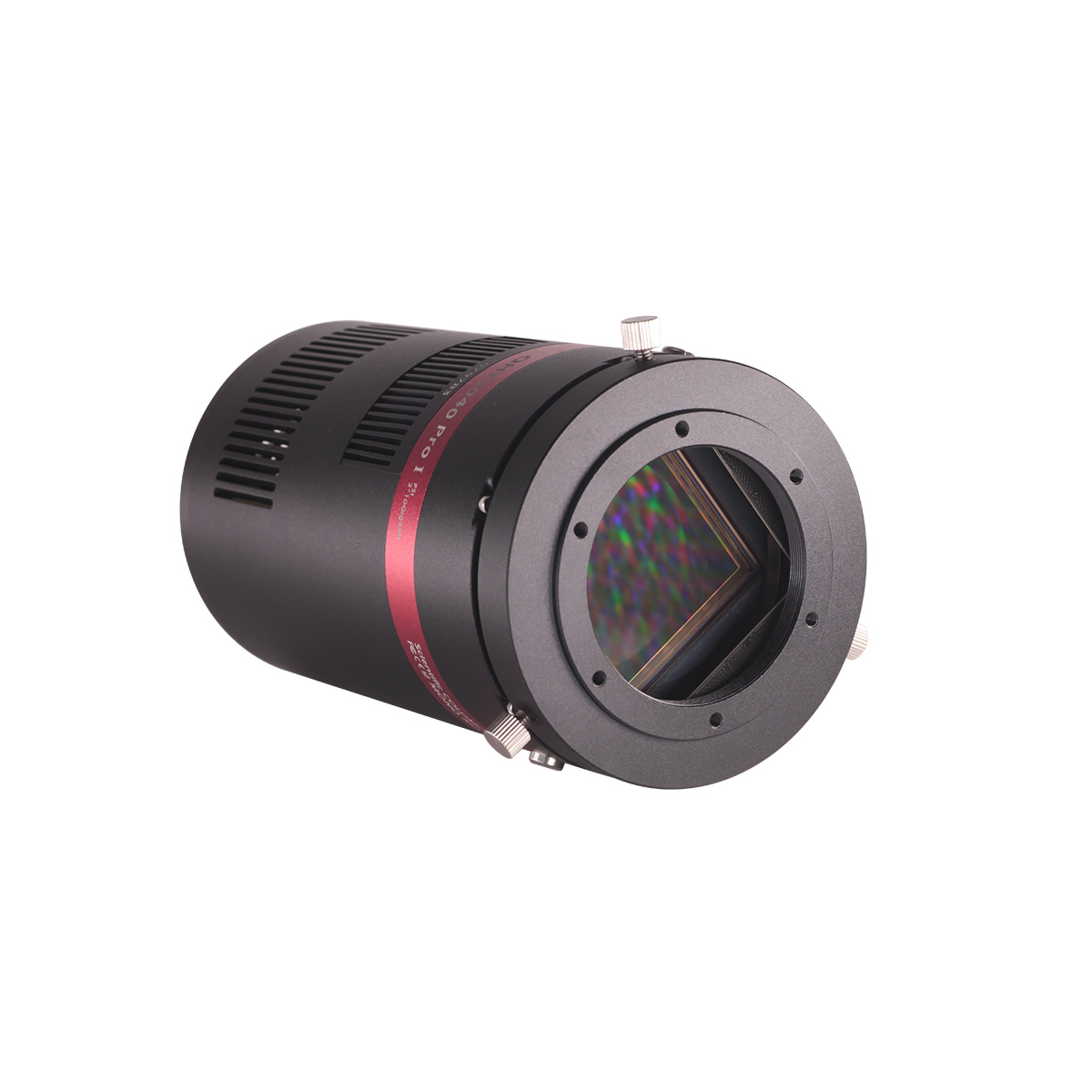
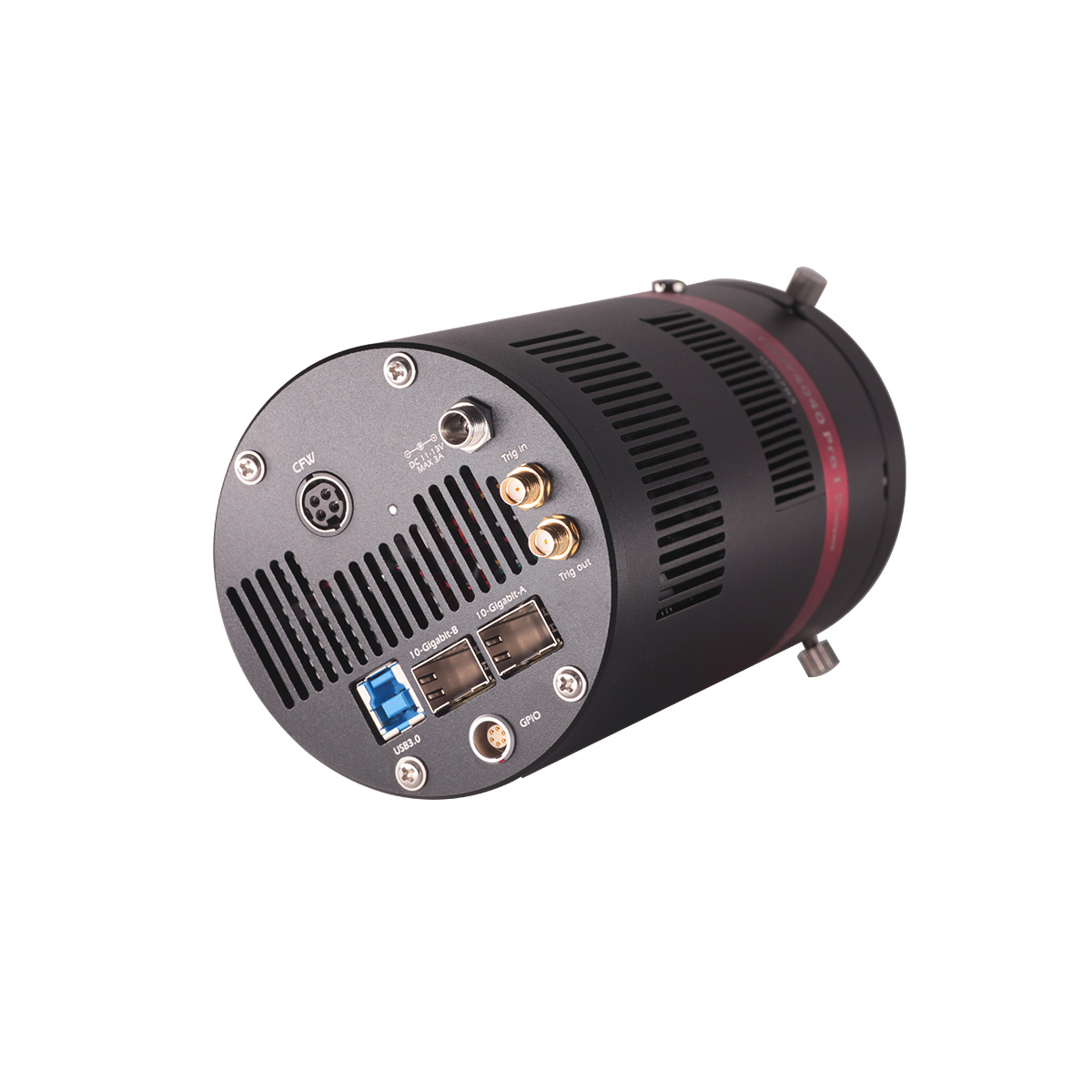

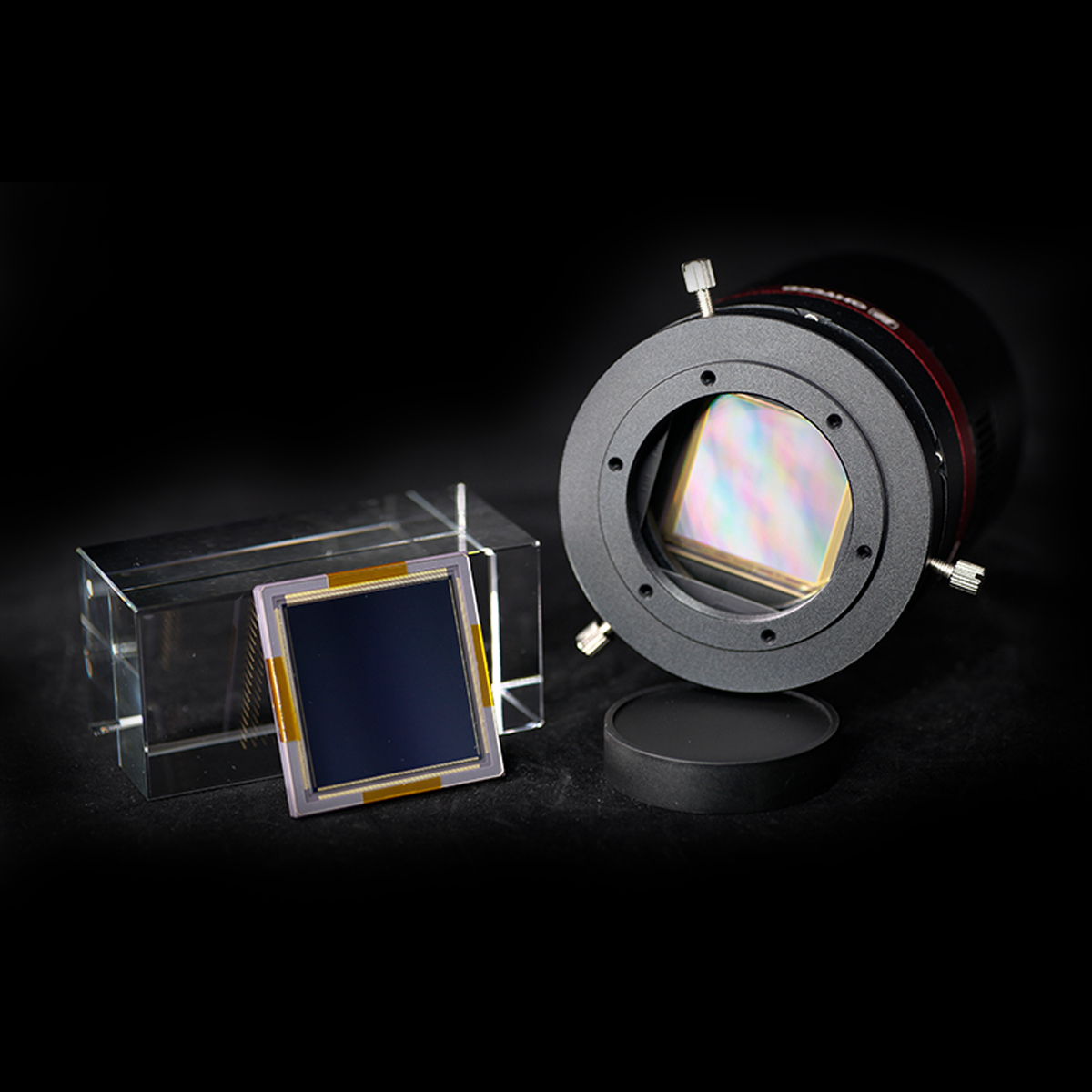
*Please contact QHYCCD about the price.
QHY4040 PRO Series ultilize Gpixel GSENSE4040 CMOS sensor, with 9.0μm pixels in a 4K*4K array. Available in both t FSI and BSI version. The BSI version has a peak QE of 90% and a wide spectrum from UV to Near IR. The QHY4040 PRO Series supports dual 12bit channel output (high gain&low gain), and also supports the in-camera dual 12bit to 16bit data combination.
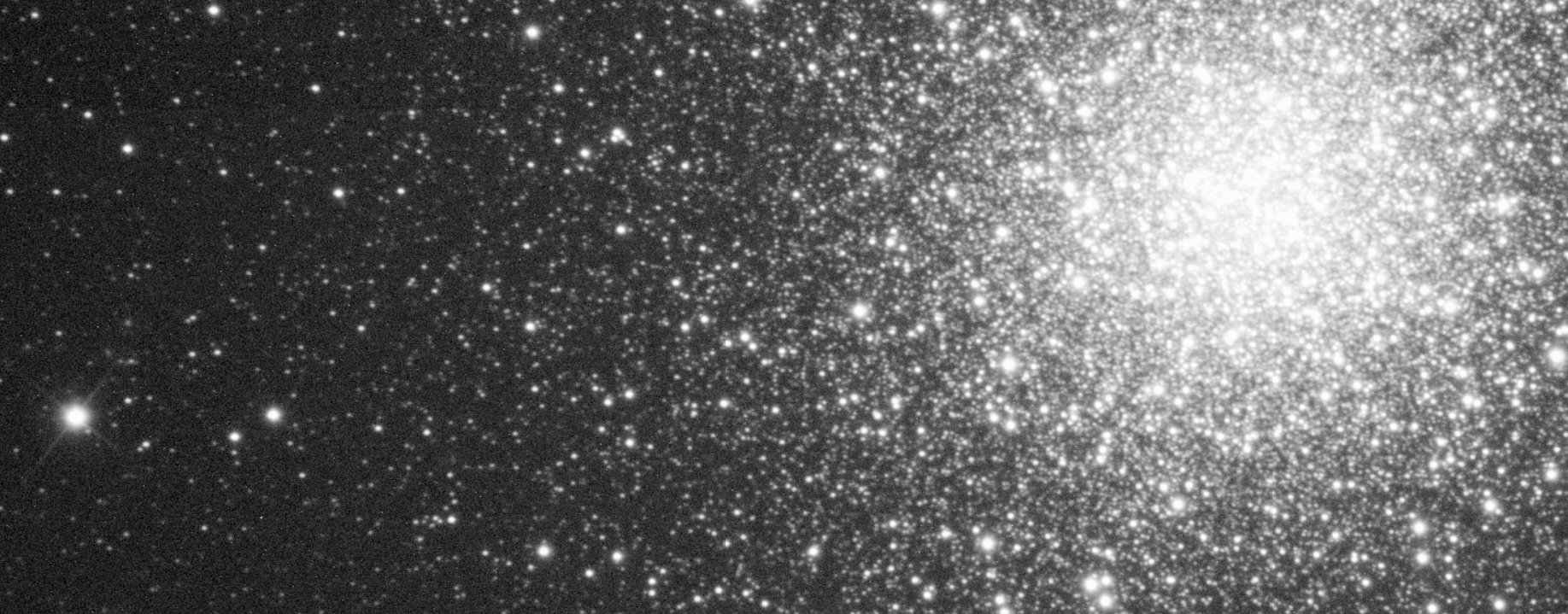 First Light of QHY4040 Pro-BSI
First Light of QHY4040 Pro-BSI
Taken together with a 50cm telescope in Corona Borealis Observatory, Ali, Tibet, China
QHY4040 Pro supports both live video mode and single-frame mode. In single-frame mode. it works at a low CMOS-driven speed. The behavior of the noise performance is the same with the 8FPS@16BIT mode in Live Video Mode which supports five different CMOS clocks. Max Frame rate from 8FPS to 20FPS.
QHY4040 Pro has zero amplifier glow. Please check the following sample.
Dark Frame Samples
10sec exposure and 30sec exposure @-7.5℃
http://note.youdao.com/noteshare?id=ae2fabb24d1742f207ba75613648e7c4
A detailed Dark Frame Samples (Gain 0 and Gain 16. -15℃, 0sec bias frame, 30, 60, 120, 300sec Dark Frame)
http://note.youdao.com/noteshare?id=848bca2fef982e0e6cf9b746b0f65ef3
About HDR mode support
QHY4040 PRO I support the dual 12bit convert to 16bit function. Users can input the combination factor and offset factor to the FPGA of the camera via an API interface. For different sensor temperatures, the offset factor needs to be calibrated.
Hardware Signal of Exposure End Time
QHY4040 PRO supports hardware exposure ending signal output. Which can be used for high precise time-domain imaging. This signal can be measured by an external timing base and you will know the precise time of the starting and ending exposure time.
Multiple Working Mode
QHY4040 PRO supports the continuous live video mode, single-frame mode, and burst mode. In the live video mode, the camera is free-running to capture the images. In single-frame mode. The camera will start capture one frame when you send the start exposure command. In burst mode, The camera will be in idle status, you can define how many frame will be output and after you send the start exposure command, it will start to capture these frames and then stop output. In both single-frame mode and burst mode, the timing is in sync with the start exposure command. It is beneficial for the high precision timing record work when working with the hardware exposure ending signal.
This picture shows the hardware exposure ending signal with a burst mode that output from the camera. This is a four frames burst. Each falling edge indicates an exposure ending time.


| Model | QHY4040 Pro I
QHY4040 Pro II |
| Image Sensor | Gpixel GSENSE4040 |
| Sensor Type | Mono Only |
| FSI/BSI | Both Available |
| Pixel Size | 9.0μm*9.0μm |
| Effective Pixels | 16.8 Megapixels |
| Effective Image Area | 36.9mm*36.9mm |
| Effective Pixel Area | 4096*4096 |
| Total Pixel | 4096*4118 |
| A/D | Dual 12bit ADC
(1)Dual Channel Output Together Mode. (2)Single Channel Mode (High Gain Channel and Low Gain Channel Seletable) (3)Dual 12bit Combine to 16bit Image mode. |
| Full Well Capacity (1×1, 2×2, 3×3)
|
FSI: High Gain Channel >70ke Low Gain Channel 26ke-
BSI: 36ke- |
| Read Noise | FSI: Typical 4e- @Gain31 (16.5x)
BSI: Typical 2.3e- @Gain50 (16.5x) |
| Dark Current | 0.29e-/pixel/sec @-15℃
0.16e-/pixel/sec @-20℃ |
| Exposure Time Range | 20μs – 600sec |
| Shutter Type | Electronic Rolling Shutter |
| Computer Interface | 1*USB3.0 Interface
2*10Gigabit Fiber Interfaces 2*CameraLink Interfaces (Pro II Version Only) |
| Filter Wheel Interface
|
4PIN QHYCCD CFW Port |
| Trigger Port | Four High Speed FPGA Controlled GPIO . Can be used for high precise GPS timestamp socket. Or the Electric Shutter on/off waveform output for GPS Card. Or Multiple Camera Synchronized Port and so on. |
| Full Frame Rates | USB3.0:
13.0FPS@8bit 10.0FPS@16bit
PCIE Mode: 13.0FPS@8bit 12.0FPS@16bit
CameraLink TBA |
| ROI Frame Rates
|
USB3.0:
2048lines, 10.8FPS@8bit, 6.1FPS@16bit 1080lines, 19.5FPS@8bit, 10.8FPS@16bit 768lines, 26.1FPS@8bit, 14.7FPS@16bit 480lines, 37.1FPS@8bit, 20.5FPS@16bit
PCIE Mode: 2048lines, 26.1FPS@8bit, 26.1FPS@16bit 1080lines, 71.8FPS@8bit, 55.8FPS@16bit 768lines, 99.8FPS@8bit, 78.4FPS@16bit 480lines, 141FPS@8bit, 106FPS@16bit |
| Built-in Image Buffer | 2GB DDR3 Memory Buffer |
| Air Cooling System | Dual Stage TEC cooler:
-35℃ below ambient (Test temperature 20℃) |
| Liquid Cooling | Available Only in LQ Version
-40℃ below ambient (Test temperature 20℃) |
| Recommended Flow Rates | 1.6ml/s |
| Anti-Dew Heater | Available |
| Humidity Sensor | Available |
| Firmware/FPGA remote Upgrade | Available via Camera USB port |
| Optic Window Type | AR+AR High Quality Multi-Layer Anti-Reflection Coating |
| Back Focal Length | 18mm(±0.5) |
| Adapters | Support 2-inch, M54, M48, Nikon/Canon DSLR Lens, etc. (Combined with adapters ) |
| Weight | About 990g |
| Power | 40W/100%
21W/50% 16.8W/0% |
*This definition is from the developer of Gsense sensors , not from QHYCCD. Please contact us if any question.
Maximum allowed defect numbers are indicated below (Updated in January, 2024).
Gsense 4040FSI Defect Limits
TBA
Gsense 4040BSI Defect Limits
| Defect limits | Grade 0 | Grade 1 | Grade 2 |
| Total defect pixels | 200 | 300 | 400 |
| Cluster (3-9) | 15 | 20 | 25 |
| Cluster (10-25) | 1 | 5 | 8 |
| Cluster (26-40) | 0 | 0 | 0 |
| Cluster (>40) | 0 | 0 | 0 |
| Defect row/column (total) | 0 | 5 | 10 |
| Adjacent rows/columns | 0 | 0 | 0 |
The camera requires an input voltage between 11V and 13.8V. If the input voltage is too low the camera will stop functioning or it may reboot when the TEC power percent is high, causing a drain on the power. Therefore, please make sure the input voltage arrived to the camera is adequate. 12V is the best but please note that a 12V cable that is very long or a cable with small conductor wire may exhibit enough resistance to cause a voltage drop between the power supply and the camera. The formular is: V(drop) = I * R (cable). It is advised that a very long 12V power cable not be used. It is better to place the 12V AC adapter closer to the camera.
First connect the 12V power supply, then connect the camera to your computer via the USB3.0 cable. Make sure the camera is plugged in before connecting the camera to the computer, otherwise the camera will not be recognized. When you connect the camera for the first time, the system discovers the new device and looks for drivers for it. You can skip the online search step by clicking “Skip obtaining the driver software from Windows Update” and the computer will automatically find the driver locally and install it. If we take the 5IIISeries driver as an example (shown below), after the driver software is successfully installed, you will see QHY5IIISeries_IO in the device manager.
Please note that the input voltage cannot be lower than 11.5v, otherwise the device will be unable to work normally.
All-in-one Pack supports most QHYCCD models only except PoleMaster and several discontinued CCD cameras.
Download Page: https://www.qhyccd.com/download/
Video Tutorial: https://www.youtube.com/embed/mZDxIK0GZRc?start=1
Before using software, make sure you have connected the cooling camera to the 12V power supply and connected it to the computer with a USB3.0 data cable. If it’s an uncooled camera, 12V power is not needed. We recommend 64-bit Software, like SharpCAP x64 , N.I.N.A x64. etc., especially when you’re using 16bit cameras.
In NINA, you can select the device to connect to QHY Camera directly without ASCOM driver.
If connecting to the camera via ASCOM is desired, first make sure you have installed both the QHYCCD ASCOM Drivers and ASCOM Platform. Then you would select the appropriate camera driver under the ASCOM section. Then click the Connect icon. Here we take NINA as an example, but it’s similar to other software packages supporting ASCOM, like MaxDL, The SkyX, etc.
Launch SharpCap. If the software and drivers mentioned above are installed successfully, the video image will appear automatically about 3 seconds after the software loads. You will also see the frame rate in the lower left corner of the software window as shown below.
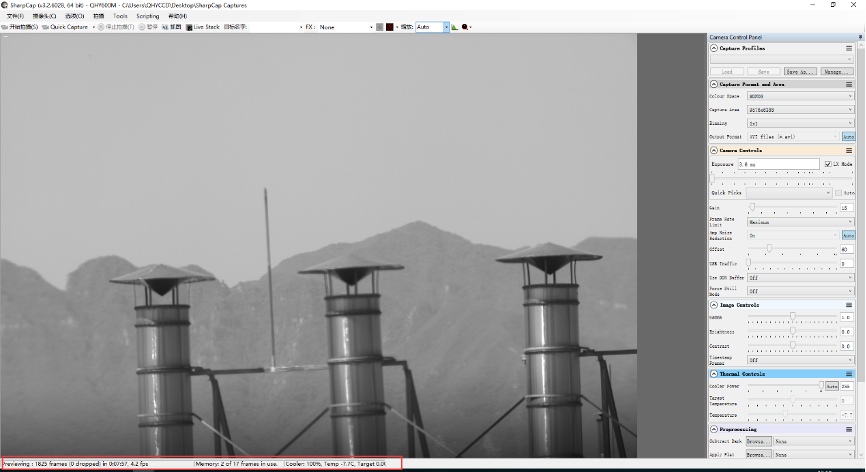

If you have already started the SharpCap software before connecting the camera, in order to open the camera, click on the “camera” in the menu bar and then select the device.
Offset adjustment. When you completely block the camera (i.e., like taking a dark frame) you may find that the image is not really zero. Sometimes this will reduce the quality of the image contrast. You can get a better dark field by adjusting the offset. You can confirm this by opening the histogram as indicated in the figure below.
If you want to enter the 16-bit image mode, select the “RAW16” mode.
By selecting the “LX” mode you can expand the exposure setting range and take long exposures.
After cooling devices connected to the 12V power supply, the temperature control circuit will be activated. You can control the CMOS temperature by adjusting the settings in the figure below. Basically, you can control the temperature of CMOS by either adjusting “Cooler Power” or clicking “Auto” and setting “Target Temperature”. You can also see the CMOS temperature at the lower-left corner of the software window.
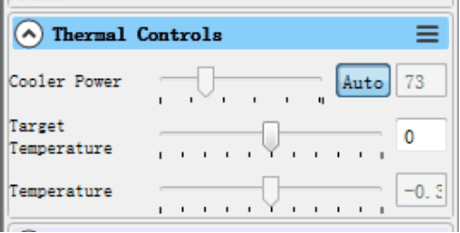

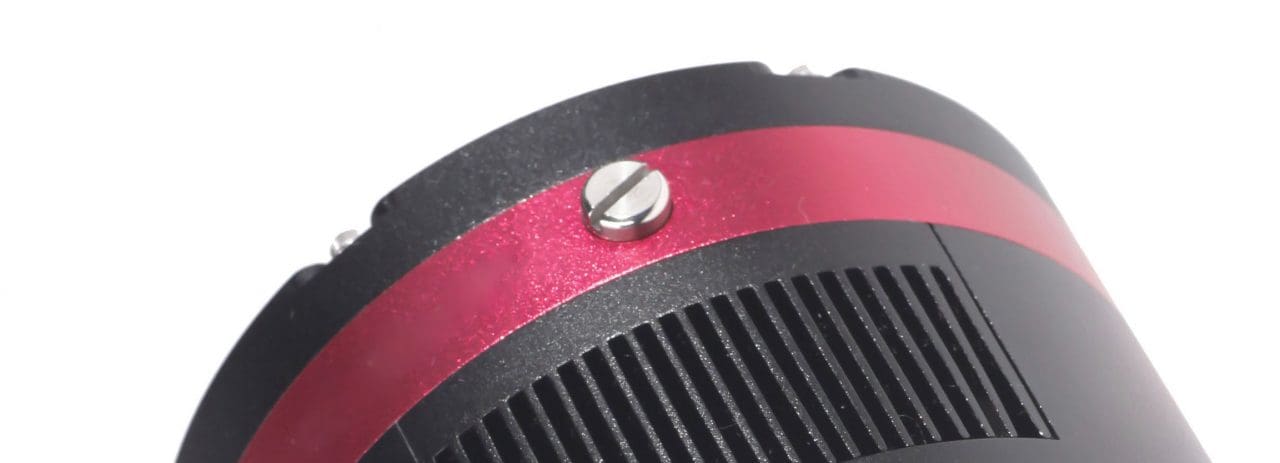

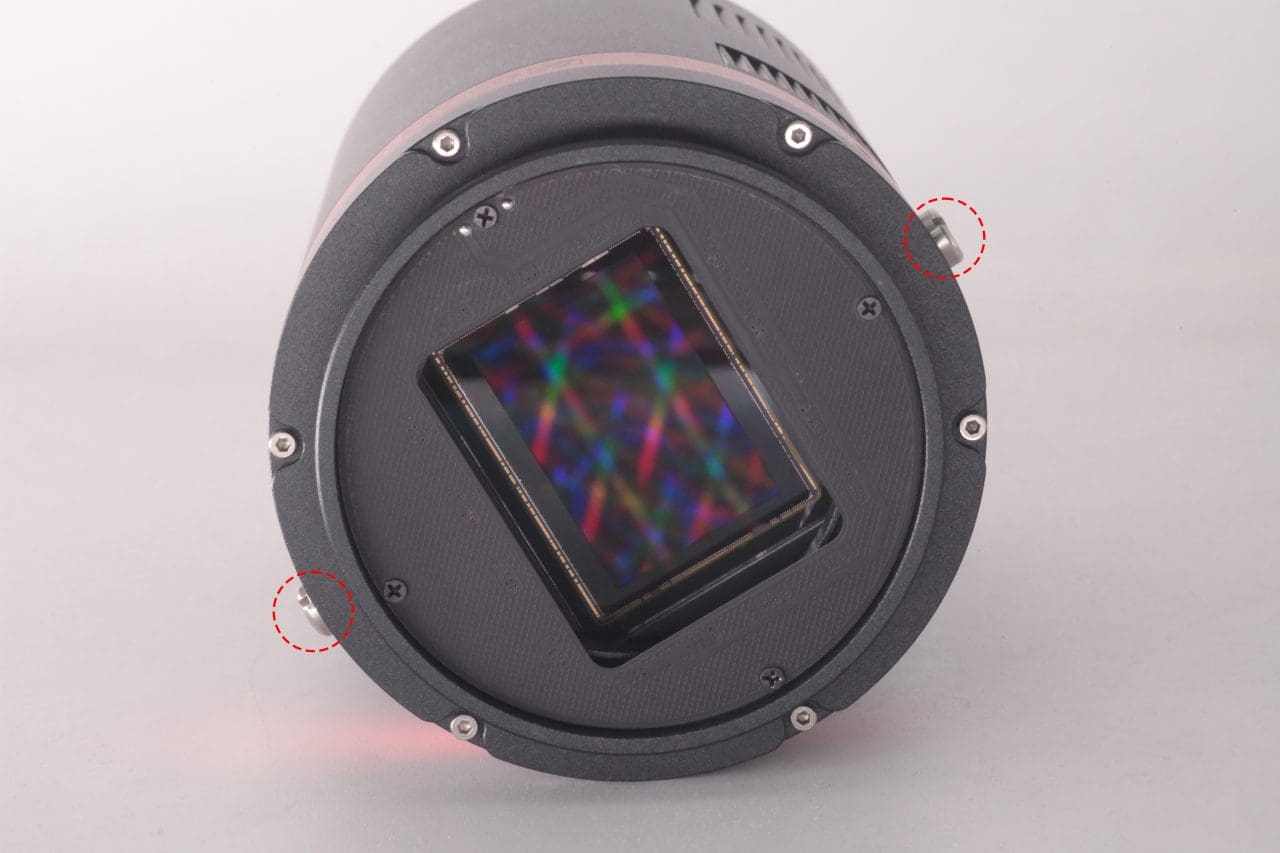

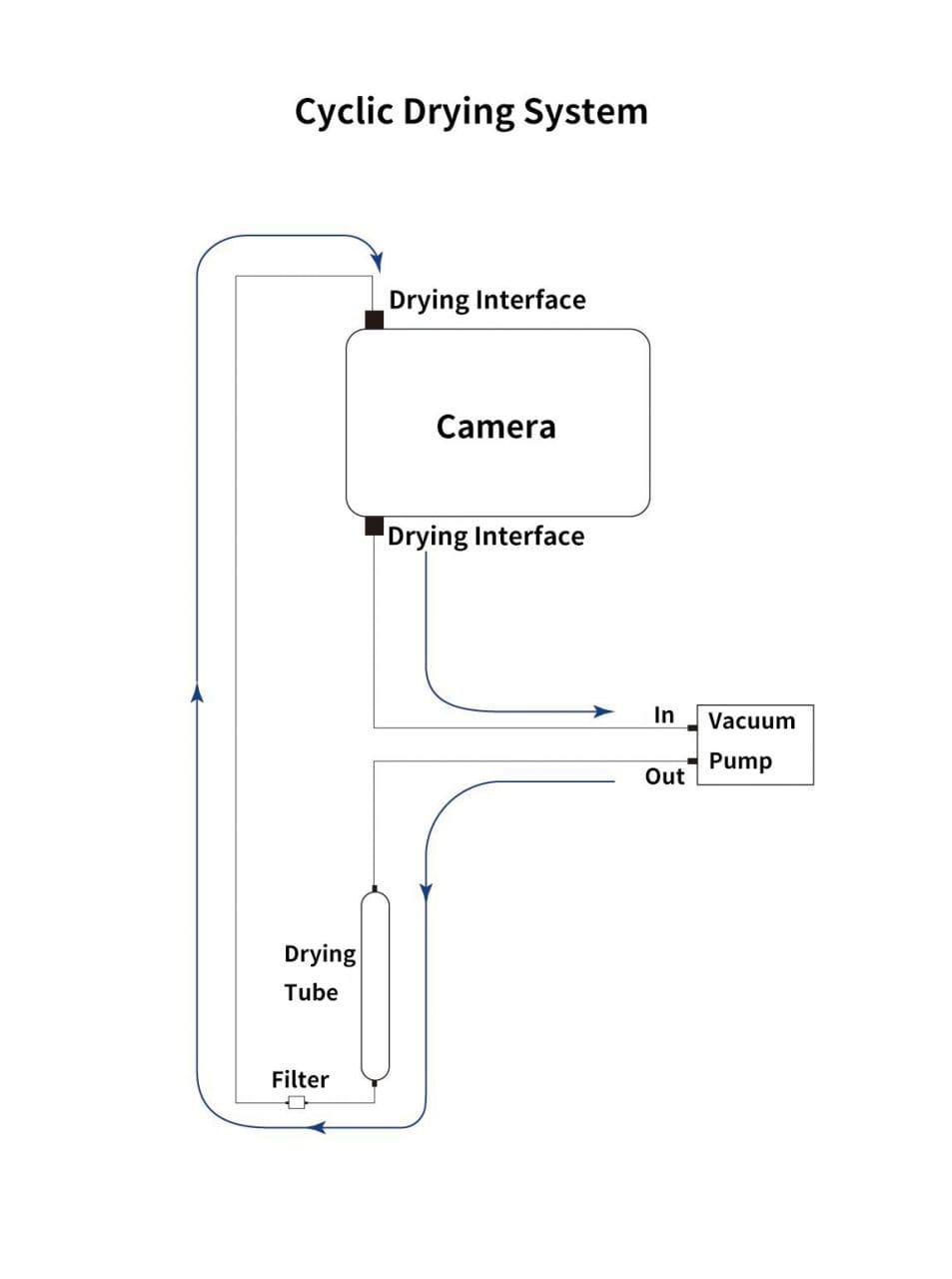

Note:1.Do not reverse the order of the intake and exhaust ports
2.Before circulating drying, it is necessary to turn off the refrigerator, and then turn on circulating drying after the temperature returns to normal temperature. Only by following this step can the water vapor in the sealed chamber be effectively removed. If the cooler is turned on, the cooler inside the camera will absorb water vapor, causing more water vapor to condense inside the camera instead of being absorbed by the desiccant.
If you find dust on the CMOS sensor, you can first unscrew the front plate of the cam and then clean the CMOS sensor with a cleaning kit for SLR camera sensors. Because the CMOS sensor has an AR (or AR/IR) coating, you need to be careful when cleaning. This coating can scratch easily so you should not use excessive force when cleaning dust from its surface.
All QHY cooling cameras have built-in heating plates to prevent fogging. However, If the ambient humidity is very high, the optical window of the CMOS chamber may have condensation issues. Then try the following:
1. Avoid directing the camera towards the ground. The density of cold air is greater than of hot air. If the camera is facing down, cold air will be more accessible to the glass, causing it to cool down and fog.
2. Slightly increase the temperature of the CMOS sensor .
3. Check if the heating plate is normally working. If the heating plate is not working, the glass will be very easy to fog, the temperature of the heating plate can reach 65-70 °C in the environment of 25 °C. If it does not reach this, the heating plate may be damaged. Please contact us for maintenance.
Please avoid thermal shock during use. Thermal shock refers to the internal stress that the TE cooler has to withstand due to the thermal expansion and contraction when the temperature of the TEC suddenly rises or falls. Thermal shock may shorten the life of the TEC or even damage it.
Therefore, when you start using the TEC to adjust the CMOS temperature, you should gradually increase the TEC power rather than turning the TEC to maximum power. If the power of the TEC is high before disconnecting the power supply, you should also gradually reduce the power of the TEC and then disconnect the power supply.
QHYCCD, the world’s leading astronomical camera manufacturer, and Gpixel, a professional company specializing in the development of high-performance CMOS image sensors, have announced the successful performance of QHYCCD QHY4040PRO-BSI camera for astronomical imaging in the Corona Borealis Observatory, Ali, Tibet, China.
The QHY4040PRO-BSI has been set up in the Corona Borealis Observatory, Ali, Tibet, China at an altitude of up to 5100 meters. “When seeing the first light M13 with an exposure time of only 5 seconds, we were all very surprised by its extremely low readout noise and high quantum efficiency. Previous equipment needed tens of seconds to achieve such results. At the same time, the Gpixel GSENSE4040BSI chip has the advantage of ultra-high sensitivity compared with the 16803 and 09000 CCD chips.” Chen Tao, the director of the Corona Borealis Observatory, said, “The QHYCCD camera still works very stably under the high altitude of 5100 meters, with excellent image quality and uniform and clean background without any strip trouble. We believe that the QHY4040PRO-BSI camera will be of great help to our sky survey projects in the future”





exposure 60 sec, -20℃, no darkfield process
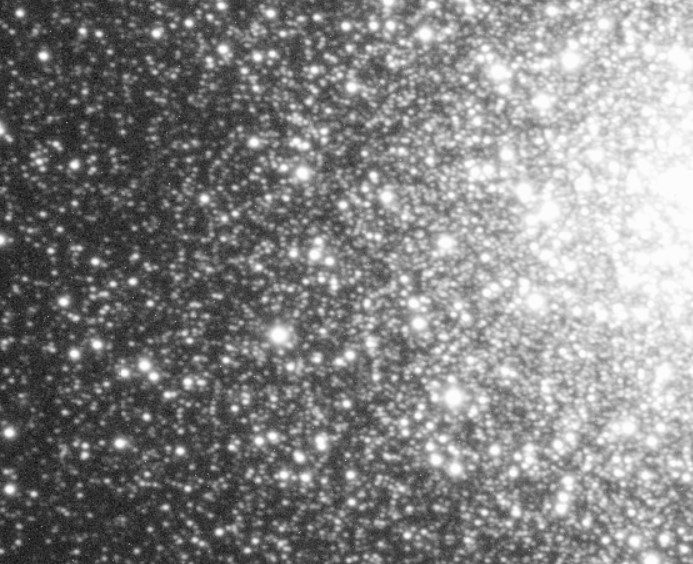

QHY4040PRO has both the FSI version and the BSI version. The BSI version was tested for this time. It has a peak QE of 90%, 39ke full-well (at the lowest gain), and 2.3e readout noise (at the highest gain). The camera is a two-stage TEC cooling with air cooling. QHYCCD can provide the water-cooling version as requested.
QHY4040 PRO-BSI supports selectable dual 12bit channel output (high gain, or low gain), and also supports the on-camera dual 12bit to 16bit data combination process. The camera has 2GByte DDR3 memory and supports a USB3.0 data interface and a 2*10Gbps optical interface for high-speed data transfer.
QHY4040PRO-BSI is equipped with a scientific cooled CMOS GSENSE4040BSI. It has a 36.9mm x 36.9mm square sensor with 9.0um pixels in a 4k x 4k array and 4096×4096 resolution. With a resolution of 4096 x 4096 and a sensing area of 36.8mm x 36.8mm, the chip can meet the needs of astronomical imaging and high-end scientific imaging. Like other products in the GSENSE series, GSENSE4040BSI features a dual gain HDR design with a dynamic range of 85dB in a single frame; the chip uses 18 pairs of LVDS for data output, and the frame rate can reach 24fps at full resolution.
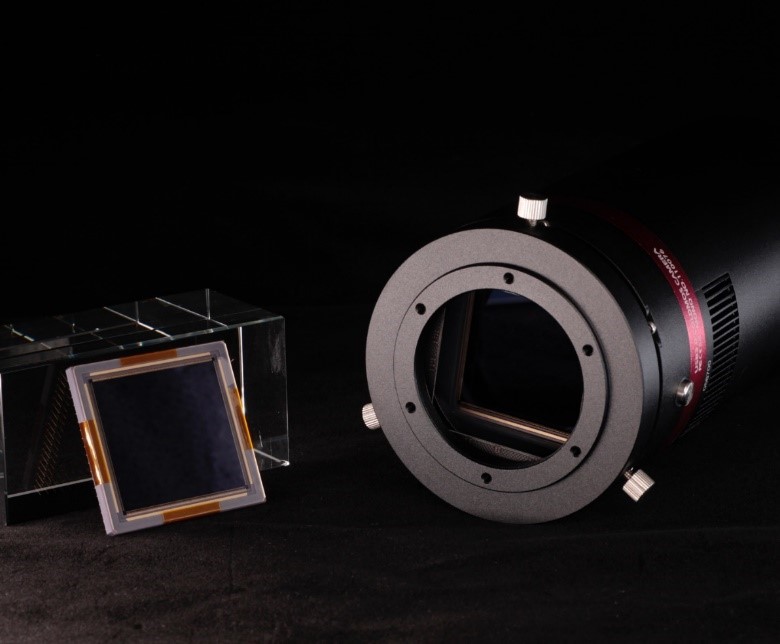

“We are proud to announce the launch of the QHY4040Pro BSI camera, which has the advantage of ultra-high sensitivity, high quantum efficiency, and low readout noise,” said Ph.D. Hong-Yun Qiu, founder of QHYCCD. At the same time, the camera can achieve a high readout rate of 10 to 20 FPS, and obtain a more excellent SNR in the same exposure time, so it can significantly improve the magnitude limit of astronomical telescope systems, and greatly enhance the observation efficiency, which is of extraordinary significance for time-domain astronomy research, space debris observation, etc.”
“We are proud to join hands with QHYCCD’s team to bring this scientific-grade astronomical camera to the market. GSENSE4040BSI is a scientific grade CMOS chip launched by Gpixel, QHY4040PRO-BSI is the first astronomical camera equipped with this chip, and we believe it will make an outstanding contribution to the study of astronomy. We are very much looking forward to its excellent performance.” Dr. Xinyang Wang, founder and Chairman of Gpixel, said, “QHYCCD is a valuable long-term partner for us, and we look forward to achieving more together and bringing more interesting solutions to the astronomical imaging market.”


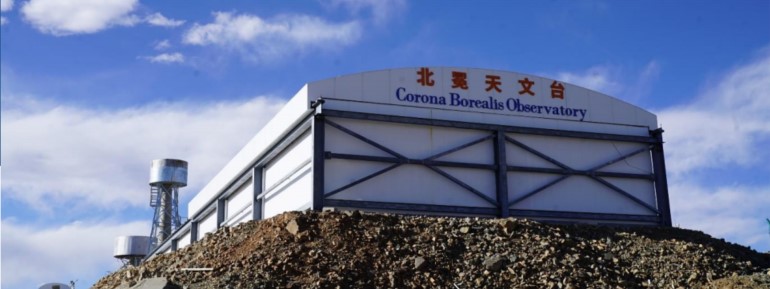

QHYCCD
QHYCCD designs and manufactures high-performance scientific-grade CMOS and CCD cameras, including thermoelectrically cooled cameras, high-resolution scientific cameras, digital X-ray machine DR cameras, solar, industrial and laboratory cameras. Most of the company’s products are exported to the United States and Europe. The QHY products are renowned for excellent performance and reliable quality.
Gpixel
Founded in 2012 by experienced CMOS image sensor designers and semiconductor physicists, Gpixel works in close cooperation with our customers and business partners to produce state-of-art CMOS image sensors for use all over the world. From our offices in Changchun, China (headquarters), Antwerp, Belgium (European design center) and Tokyo, Japan (Japanese design center) we are committed to delivering innovative and specialized high-end CMOS image sensor solutions for industrial, professional, medical, and scientific applications.
GSENSE series are scientific CMOS chips with low noise, high dynamics, and high sensitivity. The peak quantum efficiency can reach 95% through advanced BSI processing. This series is developed for high-end scientific imaging applications in the fields of astronomy, life sciences, medical imaging, spectroscopy, fluorescence imaging, high-energy physics, soft X-rays, etc. This series includes GSENSE2020BSI, GSENSE400BSI, GSENSE4040BSI and GSENSE6060BSI, GSENSE6060BSI and GSENSE1516BSI. For more information, please visit www.gpixel.com.
Corona Borealis Observatory
The highest private remote observatory in the world, Corona Borealis Observatory, located in the Ali region of Tibet, the roof of the world, at an altitude of 5,100 meters, was built with investment from founder Chen Tao and Ma Huateng from Tencent. Corona Borealis Observatory has several domes and 600-square-meter superpanning roofs, as well as a unique environment for observations. The Observatory has made several independent discoveries assisted domestic and international professional observatories in their discovery confirmation work, and collaborated on several papers. The Observatory has been open to the public for airtime rental and space rental.
https://arxiv.org/abs/2012.11456
Added functions related to BURST mode in SDK. Currently, cameras that support Burst function include QHY600, QHY411, QHY461, QHY268, QHY6060, QHY4040, QHY4040PRO, QHY2020, QHY42PRO, QHY183A
This mode is a sub-mode of continuous mode. This function can only be used in continuous mode. When this function is enabled, the camera will stop outputting image data, and the software frame rate will be reduced to 0. At this time, send relevant commands to the camera, and the camera will Output the image data with the specified frame number according to the settings, for example, set Start End to 1 6, the camera will output the image data with the frame number 2 3 4 5 when receiving the command.
Note:
1. When using Burst mode in fiber mode, the first Burst shot will be one less. For example, if the start end is set to 1 6, the output of 2 3 4 5 is normal, but in fact, only 3 4 will be output during the first burst shot. 5, 2 will not be received, the second and subsequent shots can normally obtain Burst images 2 3 4 5. This problem will be fixed later.
2. QHY2020, QHY4040 found that the frame number that came out when the exposure time was short is [start+1,end-1] but the one that came out under long exposure was [start+2,end]
3. When the camera is just connected, if the set end value is relatively large, the camera will directly output the picture after entering the burst mode. Therefore, it is necessary to set the camera to enter the IDLE state and then set the start end and related burst operations.
The following is the usage of Burst mode related functions: